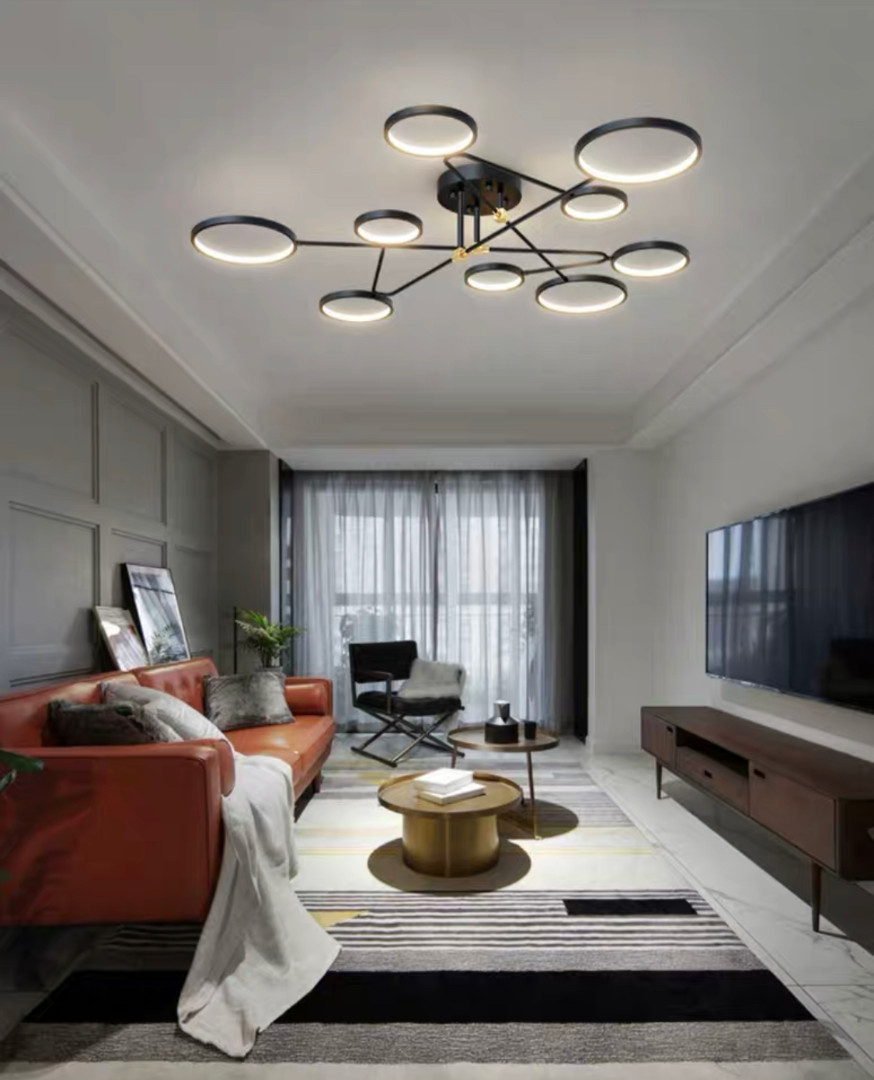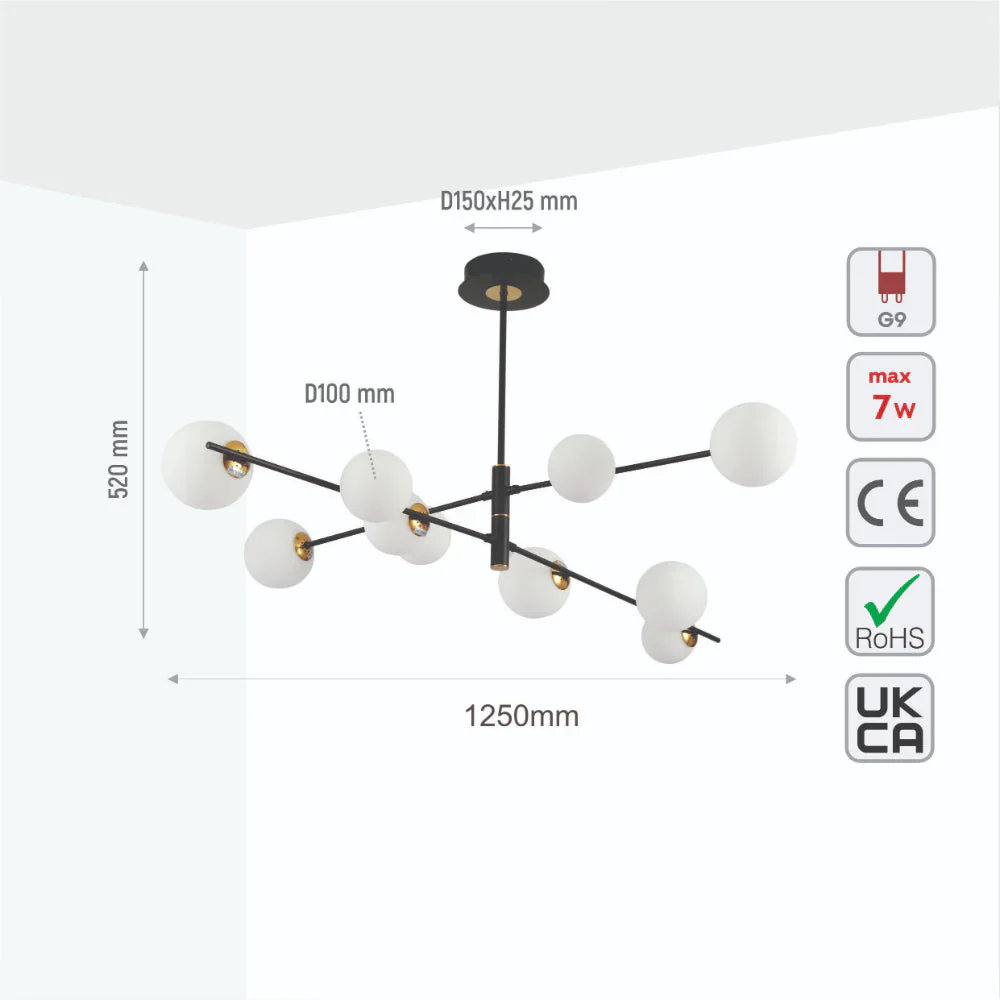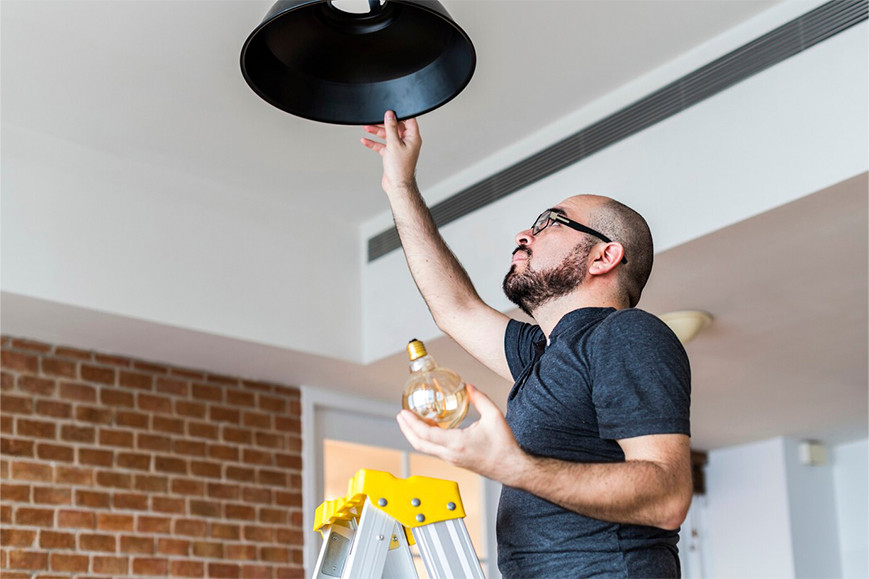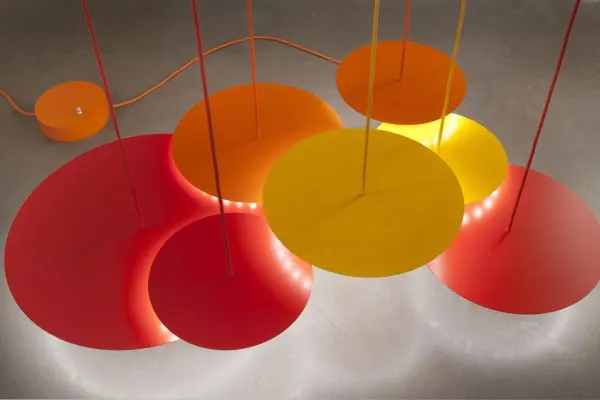Proper lighting plays a key role in creating a cozy atmosphere at home. A well-chosen chandelier for your apartment can transform any interior, making it more attractive and functional. A chandelier not only brings light into the interior but also becomes an important design element. What criteria are important to consider when choosing a ceiling lamp? How do you determine the right chandelier that will harmoniously fit into your space? In this article, we will look at types of chandeliers for the home and all aspects of choosing the right lighting fixtures for different rooms and interior styles.
Variety of Styles and Designs of Chandeliers for the Home
 The modern market offers an impressive variety of chandeliers for interior design, from exquisite classics to ultra-modern models. Isn't such a choice breathtaking? The right chandelier for a room becomes not just a light source but a true decoration of the space, defining the entire style of the room. Chandeliers in interior design play the role of not only functional elements but also important accents that set the tone for the entire room.
The modern market offers an impressive variety of chandeliers for interior design, from exquisite classics to ultra-modern models. Isn't such a choice breathtaking? The right chandelier for a room becomes not just a light source but a true decoration of the space, defining the entire style of the room. Chandeliers in interior design play the role of not only functional elements but also important accents that set the tone for the entire room.
- Classic chandeliers: These fixtures embody antique elegance and luxury. They may have crystal pendants, sophisticated shapes, and rich decorations. Classic chandeliers fit perfectly into interiors with elements of antique furniture and decor.
- Crystal chandeliers: Designs with crystal elements add shine and a special charm to the room. Crystal pendants refract light, creating a play of light and shadow that forms a unique atmosphere in the room.
- LED chandeliers: For modern interiors, there are many compact and functional LED models. They are characterized by energy efficiency, durability, and are often equipped with additional functions such as brightness adjustment or remote control.
- Kitchen chandeliers: Specially designed models for kitchen spaces combine practicality with aesthetics. They should provide sufficient lighting for work surfaces, be resistant to moisture, and easy to clean.
- Living room chandeliers: Usually larger and more expressive, as the living room is the representative space of the house where a lot of time is spent.
- Bedroom lighting chandelier: Typically has softer light and elegant, calm design suitable for a rest area. In the bedroom, it's important to create a relaxing atmosphere conducive to quality rest.
- Minimalist chandeliers: Characterized by simplicity of forms, restraint in decoration, and functionality. Ideal for modern minimalist interiors where simplicity and clean lines are valued.
- Pendant chandeliers for the kitchen: Usually installed above the dining area or island, providing directed lighting and becoming a decorative accent of the space.
The style of a chandelier for the living room or other room should harmonize with the overall design solution of the interior. When selecting a lighting fixture for your home, consider not only the aesthetic but also the functional aspect. Interestingly, more than 70% of chandeliers sold worldwide in 2024 are equipped with LED lamps, which reduces energy consumption by up to 80% compared to traditional incandescent lamps.
"When choosing a chandelier, it's important to remember the golden mean rule: the fixture should be neither too small nor too large for the room. The ideal balance is achieved when the diameter of the chandelier (in inches) is approximately equal to the sum of the room's length and width in feet." — Jonathan Adler, renowned interior designer
Room Size and Ceiling Height: Key Factors in Selecting a Chandelier
.jpg) How do you choose the chandelier size that perfectly matches your room? This question concerns many when planning lighting. When choosing a chandelier, it's necessary to pay special attention to the proportions of the room and the ceiling height to create a harmonious visual balance of lighting.
How do you choose the chandelier size that perfectly matches your room? This question concerns many when planning lighting. When choosing a chandelier, it's necessary to pay special attention to the proportions of the room and the ceiling height to create a harmonious visual balance of lighting.
- Chandelier size for the room: For small spaces, choosing a bulky design can create a sense of overload. In such cases, it's recommended to prefer compact fixtures that add lightness and visually expand the space. Specialists advise focusing on an optimal diameter that is no more than 1/3 of the room's width.
- Ceiling height: The height of the chandelier suspension directly depends on the ceiling height. In rooms with low ceilings, it's best to choose flat or semi-flat models that don't "eat up" the space. For rooms with high ceilings, multi-tiered or cascading chandeliers can visually balance the room's proportions.
- How to choose a chandelier based on ceiling height: With a standard ceiling height (2.5-2.7 m), the lowest point of the chandelier should be no lower than 2 m from the floor in walkways. If your ceilings are higher than 3 m, you can consider multi-level or pendant models with longer chains or rods.
- Chandeliers for low ceilings: If the ceiling height is less than 2.5 m, choose ceiling or semi-ceiling models that are mounted flush with the surface or have minimal suspension. They don't reduce the visual height of the room and create a sense of space.
According to design rules, when selecting a chandelier for your home, it's important to consider that the optimal height from the floor to the lower edge of the chandelier above the dining table should be 75-90 cm. For spacious halls and living rooms, this indicator increases to 210-240 cm, ensuring comfortable movement. How to calculate the diameter of a chandelier? Specialists recommend adding the length and width of the room in meters and multiplying the result by 10-12 — this is the optimal chandelier diameter in centimeters.
| Room area (m²) | Optimal chandelier diameter (cm) | Recommended hanging height (cm) | Chandelier type | Optimal power (W, LED) |
|---|---|---|---|---|
| Up to 10 | 40-50 | 210-220 | Compact, flat | 15-25 |
| 10-16 | 50-65 | 220-230 | Medium, semi-pendant | 25-40 |
| 16-25 | 65-80 | 230-240 | Pendant, multi-level | 40-60 |
| More than 25 | 80-100+ | 240+ | Large, cascade, multi-tiered | 60-100+ |
This table will help you determine the optimal parameters of a chandelier depending on the size of your room. Remember that the visual perception of the chandelier's size also depends on its design — openwork constructions look lighter than massive models with dense shades. When choosing, consider not only the area but also the geometry of the room — for narrow rooms, choose more compact models, even if the area is relatively large.
Technical Characteristics of Modern Chandeliers
 When selecting a chandelier, you should consider not only the aesthetic aspect but also the functional aspects. The right choice of technical characteristics will provide comfortable and effective lighting for many years. Isn't it important that your chandelier is not only beautiful but also practical?
When selecting a chandelier, you should consider not only the aesthetic aspect but also the functional aspects. The right choice of technical characteristics will provide comfortable and effective lighting for many years. Isn't it important that your chandelier is not only beautiful but also practical?
- Energy efficiency: Modern LED chandeliers consume significantly less electricity compared to traditional models. According to statistics, more than 62% of homeowners prefer chandeliers with a brightness adjustment function to create a customizable atmosphere, which also contributes to energy savings.
- Light adjustment: The ability to change light intensity allows creating different lighting scenarios depending on the time of day and mood. LED chandeliers with remote control are becoming increasingly popular due to their ease of use.
- Smart technologies: Approximately 15% of chandeliers sold in 2024 were equipped with control functions through apps or voice assistants such as Alexa. Such systems allow integrating lighting into the overall concept of a smart home.
- Fan chandeliers for the living room: Multifunctional devices that combine a lamp and a fan. They are particularly relevant for rooms with high ceilings where additional air circulation is required. Modern models are equipped with remote control and speed adjustment.
- Accent lighting: Some chandeliers have directed light sources that allow highlighting certain areas or decor elements. This helps create multi-level lighting and visually zone the space.
When calculating the illumination for a chandelier, it's important to consider the functional purpose of the room. Work areas require brighter lighting (300-500 lux), while relaxation areas need only 150-200 lux. Lighting standards for rooms of various purposes are regulated by special standards that take into account ergonomic requirements and visual comfort.
Lamp Types and Their Impact on Lighting Quality
 Choosing suitable lamps for a chandelier is crucial for creating a comfortable lighting atmosphere. Each type of lamp creates its unique color temperature of light and has different energy efficiency characteristics.
Choosing suitable lamps for a chandelier is crucial for creating a comfortable lighting atmosphere. Each type of lamp creates its unique color temperature of light and has different energy efficiency characteristics.
- Incandescent lamps: Although these lamps create a pleasant warm light, they consume a lot of energy and have a short lifespan. Their use is gradually decreasing in favor of more economical options.
- Halogen lamps: These light sources are an improved version of incandescent lamps. They provide bright lighting and have a longer lifespan, although their energy efficiency still lags behind modern alternatives.
- Fluorescent lamps: Characterized by high efficiency and long lifespan. They create predominantly cool light and are ideal for work areas requiring good illumination.
- LED lamps: The most energy-efficient option today. LEDs provide excellent light quality with minimal energy consumption. Did you know that modern LED lamps can last up to 50,000 hours, which is approximately 25 years when used 5-6 hours per day?
The color temperature of light plays a key role in shaping the atmosphere of a room. Warm light (2700-3000K) creates a cozy, relaxing environment, ideal for living rooms and bedrooms. Neutral light (3500-4100K) is well-suited for kitchens and work offices. Cool light (5000-6500K) imitates daylight and is suitable for work areas requiring high concentration.
"Psychologists note that chandeliers with warm light (2700–3000K) can enhance the feeling of comfort and relaxation by 20%. Choose LED lamps with the right color temperature to create the desired mood in the room." — Dr. Sarah Campbell, environmental and design psychologist
When selecting lamps for a chandelier, pay attention to the materials of the chandelier shades. Transparent and translucent materials best transmit the brightness and color temperature of the light source, while matte or colored shades can significantly change the lighting characteristics.
Practical Tips for Installing and Maintaining a Chandelier
 Even a perfectly chosen chandelier won't please the eye if it's improperly installed or poorly maintained. How do you install a chandelier correctly and preserve its attractive appearance for many years? Here are a few practical recommendations.
Even a perfectly chosen chandelier won't please the eye if it's improperly installed or poorly maintained. How do you install a chandelier correctly and preserve its attractive appearance for many years? Here are a few practical recommendations.
Safe Chandelier Installation
- Turn off the electricity: Before starting installation, be sure to turn off the power at the panel. Use a voltage tester to ensure there is no current in the wires.
- Check the ceiling structure: Make sure the ceiling can support the weight of the chandelier. If necessary, install additional support or a special mounting plate.
- Follow the instructions: Each chandelier has its own installation specifics. Carefully study the manufacturer's manual and strictly follow the directions.
- Correctly connect the wires: Usually, a chandelier has three wires: phase (brown or black), neutral (blue), and grounding (yellow-green). They must be correctly connected to the corresponding wires in the ceiling.
- Check the fasteners: After installation, check the reliability of all connections and fasteners. The chandelier should not wobble or rotate.
How to Care for a Chandelier

- Regular cleaning: Dust and dirt on the shades and decorative elements reduce the brightness of lighting. It's recommended to clean the chandelier at least once every 3-6 months.
- Suitable cleaning agents: Use a soft dry cloth to remove dust. For glass and crystal elements, you can use special compositions without ammonia and alcohol.
- Cleaning crystal elements: To preserve the shine of crystal pendants, use a mixture of warm water and a small amount of mild detergent. Wipe each element with a soft cloth, then dry thoroughly.
- Timely lamp replacement: Don't wait until the lamp completely fails. Flickering or dim lamps should be replaced in advance to avoid voltage fluctuations that can damage the electronic components of the chandelier.
- Wiring inspection: Periodically inspect visible parts of the wiring for damage, especially if you have pets.
By following these simple recommendations, you can significantly extend the life of your chandelier and preserve its aesthetic appeal. Remember that an excessively dusty chandelier not only looks untidy but also loses up to 30% of its light output, which reduces lighting efficiency and increases electricity costs.
with a soft cloth, then dry thoroughly.
- Timely lamp replacement: Don't wait until the lamp completely fails. Flickering or dim lamps should be replaced in advance to avoid voltage fluctuations that can damage the electronic components of the chandelier.
- Wiring inspection: Periodically inspect visible parts of the wiring for damage, especially if you have pets.
By following these simple recommendations, you can significantly extend the life of your chandelier and preserve its aesthetic appeal. Remember that an excessively dusty chandelier not only looks untidy but also loses up to 30% of its light output.
Ceiling Materials and Structure: What to Consider During Installation
The selection and installation of a suitable chandelier depend not only on aesthetic preferences but also on the technical features of the ceiling. How do you install a chandelier correctly to avoid problems in the future? This question concerns many owners when planning interior upgrades.
- Ceiling type: The structural features of the ceiling significantly affect the choice of chandelier. For example, chandeliers for stretch ceilings require special attention — it's necessary to choose models that don't heat the surface and don't deform the material. Concrete ceilings need special fasteners capable of supporting the weight of a massive model.
- Materials: With wooden ceilings, special caution should be observed in choosing lighting fixtures, preferring models with low heat emission. For drywall constructions, it's important to use special fasteners and distribute the load from heavy chandeliers.
- Electrical wiring: Before choosing a chandelier, it's necessary to evaluate the condition and capabilities of the existing electrical system. Designer handcrafted chandeliers and modern models with expanded functionality may require additional wires or wiring reinforcement.
How to combine a chandelier with the interior of a room? Want to learn more about combining chandeliers with furniture and other decor elements? Specialists recommend maintaining a unified style and color scheme to create a harmonious space. For example, metallic elements of the chandelier can be repeated in furniture fittings or decorative accessories.
Crystal Chandeliers: Features and Unique Properties
.jpeg) Crystal chandeliers are traditionally considered a symbol of luxury and refined taste. Their unique optical properties create a special atmosphere in the interior that is difficult to replicate with other fixtures.
Crystal chandeliers are traditionally considered a symbol of luxury and refined taste. Their unique optical properties create a special atmosphere in the interior that is difficult to replicate with other fixtures.
Crystal chandeliers bring a special charm to a classic interior thanks to the high lead content (up to 30%) in the material, which provides superior light refraction and creates rainbow highlights. These fixtures become not just a light source but a true work of art. When choosing between crystal and glass for a chandelier, it's important to understand that crystal elements have better light-reflecting properties.
"A crystal chandelier not only illuminates the space but also fills it with special energy. The play of light in the facets of crystal creates a unique atmosphere of celebration and luxury even on the most ordinary day." — Philippe Starck, world-renowned designer
Interestingly, the global chandelier market in 2023 was valued at $6.5 billion and, according to forecasts, will grow at an annual rate of 4.2% until 2030. Crystal remains the leader (45% of the market), followed by metal (30%) and glass (20%) in chandelier production. One of the typical mistakes when choosing chandeliers is underestimating the weight of crystal constructions, which require reliable ceiling attachment.
How to care for a crystal chandelier? Experts recommend regular cleaning with a soft cloth using special agents that don't contain abrasive particles. For more thorough cleaning, it's recommended to disassemble the chandelier, treating each element separately. This is a labor-intensive process, but it's necessary to maintain the impeccable shine of crystal pendants.
Conclusion: Create Perfect Lighting with a Properly Chosen Chandelier
Selecting a lighting fixture for your home is a combination of art and science. Considering the chandelier size for the room, ceiling height, interior style, and technical characteristics, you can create perfect lighting that will transform your living space. Modern trends in chandeliers offer many innovative solutions, from energy-efficient LED models to smart systems with remote control.
Don't forget about the importance of harmony in the interior and visual balance of lighting. A chandelier should organically fit into the interior, matching with other decor elements and furniture. When choosing lighting fixtures, pay attention to materials, color scheme, and stylistic direction. Remember that well-chosen lighting can not only functionally illuminate the room but also create a special atmosphere that emphasizes your individual style.
Use our recommendations for selecting a chandelier and expert advice to avoid common mistakes when choosing chandeliers and enjoy beautiful and functional lighting in your home for many years. The right chandelier for a room is not just a light source but an important design element that can become a true "highlight" of your interior, attracting admiring glances from guests and creating a comfortable atmosphere for you and your family.

